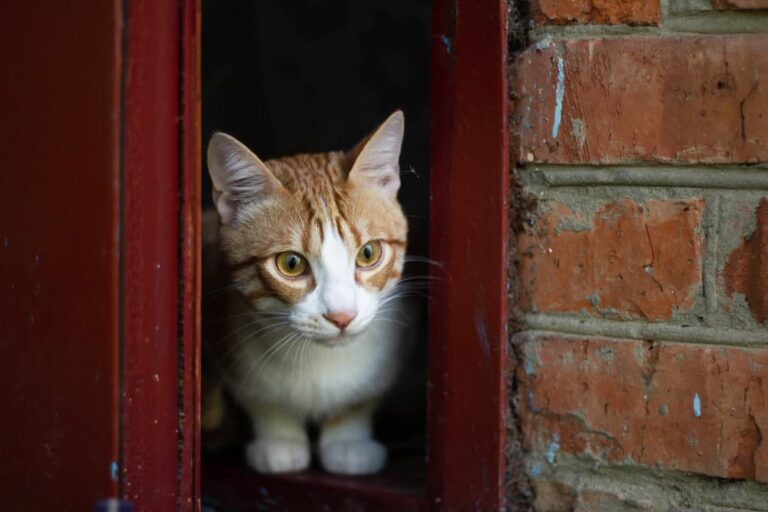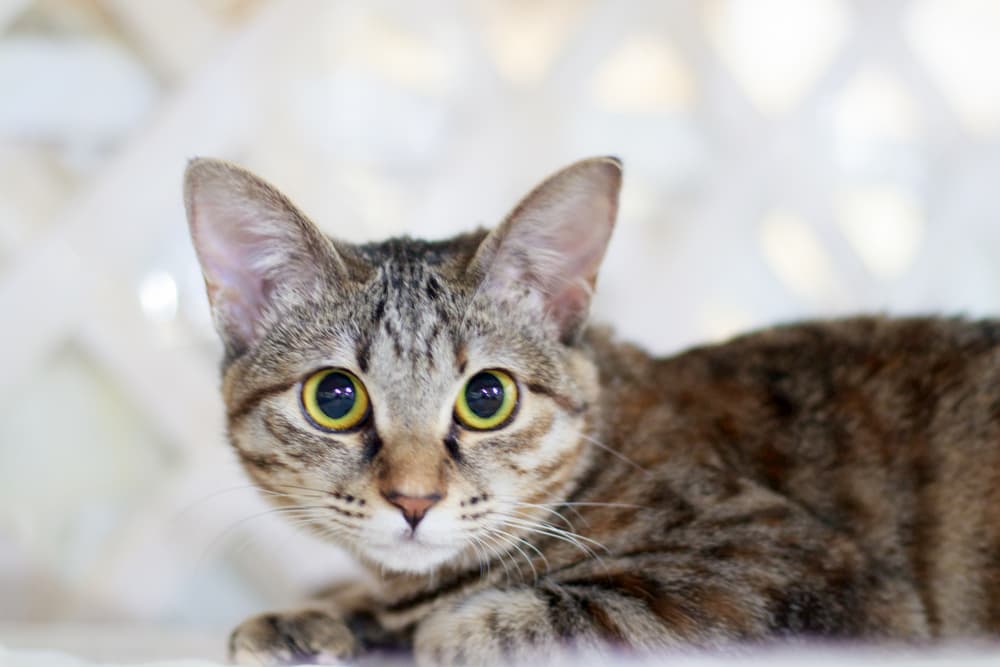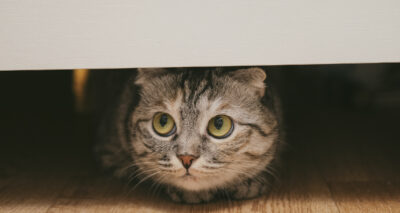How to Calm a Cat: Tips and Advice

Petting a cat can reduce stress and anxiety in humans (1). But what about when our whiskered friends are the ones feeling anxious?
While some cats are laidback enough to roll with almost anything, others are more easily frazzled during stressful situations. In fact, your cat may be showing you she’s anxious more often than you realize. From trembling and hiding, to skipping the litter box and excessive meowing, cats have many ways of telling you they’re stressed.
Here are some tips and advice on how to calm a cat who’s scared, stressed, or hyperactive.
Understanding Cat Behavior: Anxiety, Fear, and Hyperactivity

“There are many things that can stress out cats,” says Christine Calder, a certified veterinary behaviorist and the director of behavior services for Midcoast Humane. By nature, cats are both prey animals and predators, so “fear is a hardwired emotion in cats,” Calder notes. As a result, many are easily rattled.
Calder says there are several common situations that trigger this response. These instances include meeting unfamiliar people, dogs, cats, loud noises, new environments, car rides, visits to the veterinarian, and handling.
Other times, you may need to calm a cat for reasons that have nothing to do with fear. For instance, when he goes on a late-night, hyperactive rampage while you’re trying to sleep.
Whether it’s fear or hyperactivity, there are steps you can take to help calm a cat down, whatever the root cause.
How to Calm Down a Cat

In general, Calder says it’s best to give cats plenty of space to retreat to when they’re anxious or scared so they can feel safe.
Jennifer Van de Kieft—a certified feline training and behavior specialist who runs the consulting company Cat Advocate LLC—also notes that when it comes to cats and stress, “it’s so much easier to prevent fear than it is to treat it.”
That means pet parents should not only have foresight into what could frazzle their cat, but also work on advance training and familiarization for situations you know will arise in the future—like a trip to the veterinarian.
How to Calm a Cat at Night

Knowing how to calm a cat down at night may be the key to getting a good night’s rest yourself. Again, this is less about a stress issue for cats, and more about an uneven match between their natural schedules and ours. Since cats see best in low light, they’re hardwired to be most active at dawn and dusk.
“I get this one all the time,” Van de Kieft says. “It’s astounding to me how often people are not sleeping” because of their cat’s behavior. “Cats sleep a lot during the day, especially if you’re at work,” she adds. “Then maybe they’re running around at midnight or up at 4 a.m. and expecting you to feed them.”
Van de Kieft recommends upping your cat’s daytime enrichment options. This way, he plays on his own during daylight hours instead of saving his energy to rampage through the house at night. Young and adult cats need at least two play sessions a day, she says, in the morning and evening. Senior cats need scheduled playtime once a day, too.

“Cats have a normal rhythm: hunt and then eat what they hunted, relax, and go to sleep,” Van de Kieft says. She suggests playing with your cat close to your own bedtime and providing a dry food snack afterward. Or, consider leaving it out in a food puzzle to give your cat something to work on overnight.
“If all that doesn’t work,” she adds, “get a timed feeder. If the cat starts meowing at 4 a.m., have a snack set to go off at 3:45.”
Calder also recommends food-dispensing and puzzle toys in the evening for a calming effect. She says that night waking in older cats can also be due to cognitive or sensory decline.
Whatever the cause, “it is important not to try and stop or correct the behavior, as this can sometimes be reinforcement,” Calder says. Instead, “keep the cat busy with other things to do.”
How to Calm a Scared Cat

When your cat is scared, one of the best things you can do is give her space. Don’t try to pick her up or move her. Some cats may redirect their stress onto you and become aggressive, says Calder.
Instead, Van de Kieft recommends quickly removing the source of stress and then closing your scared cat off in one room, dimming the lights, and even putting on some stress-reducing cat music (2). Make sure the room has all your cat’s essentials inside: litter box, food, and water. Then give her time and space to decompress.
“Sometimes when cats are upset, it can take a couple hours to calm down,” says Van de Kieft.
Calder says it may also be helpful to try redirecting your cat’s focus with a behavior they’ve learned. Tricks like “touch” or “targeting” (when a cat touches their nose to a finger or target) can help redirect their fear.

Van de Kieft notes that play can help too, especially for young cats: “Exercise makes you forget about what’s going on.”
For hard to avoid traumatic moments—like running the vacuum or going to the veterinarian—work on positive associations. For instance, try doling out treats anytime you vacuum.
And if your cat is still young, Van de Kieft says the best thing you can do is expose her to as many varied situations as possible. “Have friends over, have kids over, get them used to different experiences—it builds resilience,” she says.
How to Calm a Cat in the Car

Whether it’s a quick trip to the vet or a long-distance vacation, car rides can be stressful for cats.
Addressing that stress begins with advance training, Van de Kieft says. She recommends starting with the cat carrier. Many people stow carriers in their basement or closets, only bringing them out for car trips. As a result, “your cat knows that when the carrier comes out, something bad is going to happen,” she says.
Van de Kieft says the best thing you can do is leave your carrier out all the time. Make it a safe, secure spot where your cat can hang out whenever he chooses. Stock it with treats, fresh bedding, catnip, food and toys. “This way, their carrier can become a place of safety,” Van de Kieft says. “When you travel, it’s like taking a piece of their home with them.”
To reinforce those happy carrier feelings, Van de Kieft recommends taking a short walk with your cat in his carrier around the house, then in the hallway, then outside. You can reinforce with treats if you’d like.

Next up: a short drive in the car in which nothing bad happens and the treats are plentiful.
By doing this, “you get ahead of the fear before it actually happens and create positive associations with the carrier,” Van de Kieft says.
When it’s time for an actual drive somewhere, she suggests bringing along cat snacks and making sure there is good airflow in the car. It can also help to bring something soaked in your cat’s scent, like a towel you’ve left out for her to sleep on in advance.
For cats who are still anxious in the car, Van de Kieft and Calder both recommend pheromone sprays. These products that mimic the natural cat pheromones linked to calm and peaceful feelings. You can spritz this cat calming spray onto a towel or straight into the carrier itself. Calder also recommends securing the carrier and covering it with a towel to help your cat feel safer on the road.
For cats that need some extra help, Calder sometimes prescribes gabapentin for car-induced stress.
Other supplements, including hemp-oil products for cats, may relieve stress and anxiety during car rides. But make sure to speak with a veterinarian before giving your cat a new product.
How to Calm a Cat After Moving

Relocating to a new home or apartment can be difficult for cats, who love routine and familiarity. If you’re moving with cats, Van de Kieft says this isn’t the time to buy a new scratching post or debut a different cat bed. Since a new place will smell different, “bring as much stuff as possible that smells like the cat, so there are familiar things there,” she says.
Van de Kieft also suggests plugging in a feline pheromone diffuser a few weeks in advance of arriving with your cat.
Calder and Van de Kieft both recommend designating a single “safe space” room for your cat when moving into a new place. Fill it with all her familiar belongings. Also, make sure there are separate areas for using the litter box, resting, eating and drinking. Let her get comfortable and used to that room before introducing her to the rest of the new home, one space at a time.
Meanwhile, stick to her usual schedule for feeding and playtime as much as possible.
Cat Calming Products to Consider

There are several products on the market designed to help calm down anxious cats.
Beyond pheromone diffusers, wipes or sprays, Calder sometimes recommends nutritional supplements designed to relieve anxiety. You should always speak with your own veterinarian first before adding or changing your cat’s diet.
For some cats, Calder will prescribe medications to help reduce fear and anxiety.
Something Calder doesn’t suggest to pet parents as a cat anxiety treatment? Essential oils. “Essential oils can be toxic to cats, especially if ingested.”









